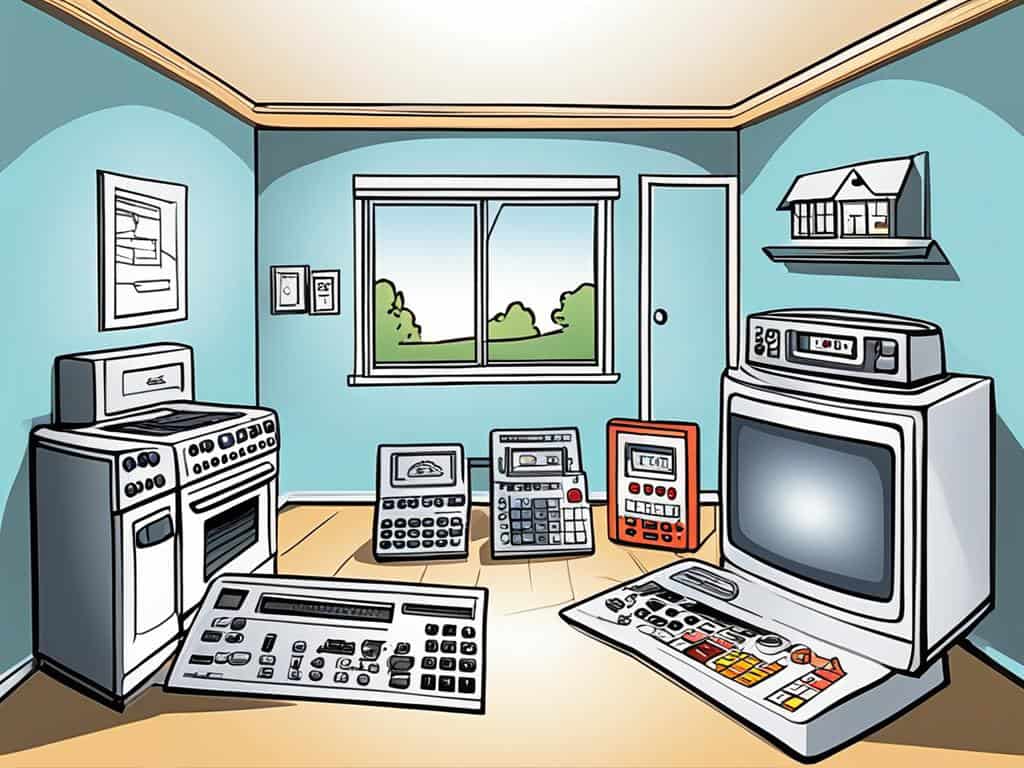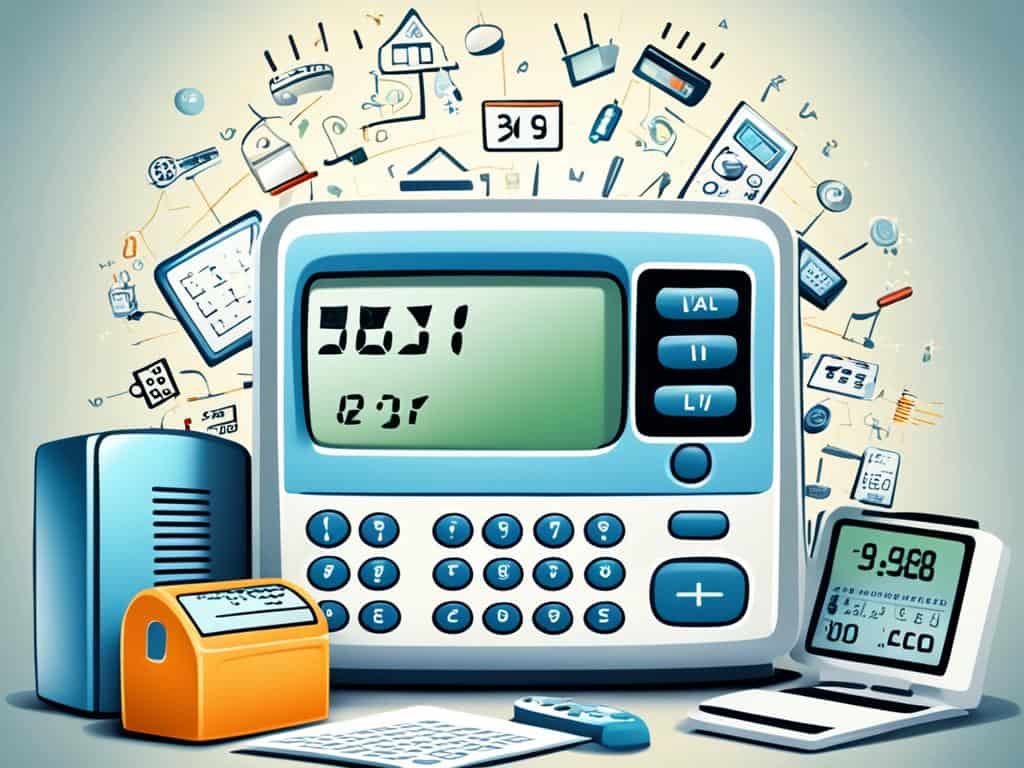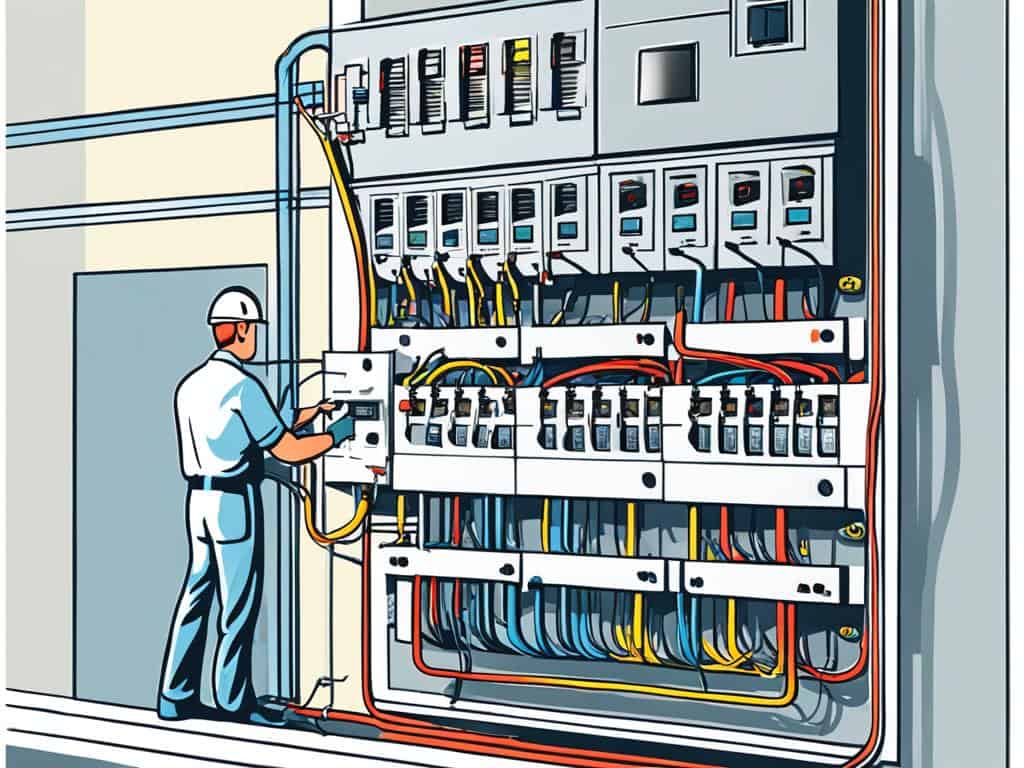Accurate House Load Calculation Guide 2024
Master your home’s energy needs with our comprehensive guide to house load calculation. Optimize comfort & savings in 2024 with expert tips.

Our modern lives depend on a dance of electrons, yet few homeowners know the NEC sets a 100-amp minimum. For homes with dreams of lush theaters or steamy hot tubs, up to a 400-amp service may be needed. With careful house load calculations, you can balance your home’s energy needs and electrical supply. This makes sure all your appliances work smoothly.
Calculating your home’s load is more than safety; it’s about efficiency. This detailed process helps avoid overloads. It also helps you make smart choices on energy use, upgrades, and new installations.
Knowing your home’s total energy need is crucial. With Manual J 8th Edition and ACCA’s help, you’re set. You’ll keep your home’s energy use in perfect harmony, from LEDs to HVACs and gadgets.
Key Takeaways
- Understand the minimum 100-amp service prescribed by NEC for modern households.
- Recognize that high-energy demands may require up to a 400-amp service.
- Awareness of the importance of following the Manual J 8th Edition for HVAC system sizing.
- Discover ACCA resources that enable homeowners to perform an accurate load calculation.
- Comprehend the necessity of energy assessments for safe and efficient home energy use.
- Realize that effective electrical load calculations contribute to optimal home energy management.
- Grasp how Manual J updates and ACCA resources streamline house load calculations.
Understanding House Load Calculation: What You Need to Know
Managing your home’s energy use starts with understanding electrical load. This load shows the power any device uses when it’s working. Assessing this load is key during a home energy audit. This audit checks the energy use of all appliances and fixtures. It improves efficiency and prevents electrical dangers.
Defining Electrical Load in a Residential Context
Electrical load in homes is about how much power devices need. It includes everything from small lights to big heating systems. Knowing this helps plan electrical circuits and assessments.
The Importance of Precise Load Calculations for Home Efficiency
Precise load calculations are vital for home efficiency. It guides updates and new appliance choices, keeping loads safe. Here’s a look at how managing a home’s electrical load boosts performance:
| Statistic | Details | Relevance |
|---|---|---|
| Load Capacity | The total load capacity of an electrical panel should not surpass 80% of its rating. | Keeping the load under this limit prevents electrical risks. |
| Ohm’s Law Application | To calculate load capacity accurately, Ohm’s Law (A x V = W) is used. | It’s a mathematical way to work out capacity. |
| Realistic Circuit Capacity | A 20-amp circuit ideally has a usable capacity of 1920 watts. | This knowledge aids in planning without overloading circuits. |
| Percentage of Usage | Calculating the load on a circuit can yield a usage percentage, such as 42% on a 20-amp circuit. | It shows how much more we can safely add. |
An energy audit will calculate these to keep systems safe when adding devices. Consider total load capacity before getting new appliances or starting renovations. Often, you might need a professional, like a level 2 electrician. Companies like Sydney North Shore Electrician are experienced and focus on safety and transparency.
By doing a detailed energy assessment, homeowners can make smart choices. This leads to a safer, efficient, and cost-saving home.
The Significance of Calculating Your Home’s Energy Consumption
Understanding how much energy your home uses is crucial. It goes beyond simple budgeting. It is a big step towards being more energy-efficient. An energy audit helps you make smart choices. For example, you can figure out which appliances to keep or upgrade. Knowing your home’s energy needs is also the first step in planning for solar power. This supports your goals for independence and eco-friendliness.
- Electricity usage monitors help you figure out how much power devices on 120 volts use.
- Bigger appliances, like dryers and air conditioners running on 220 volts, need whole-house energy monitors.
- You can buy electricity usage monitors at hardware stores for about $25-$50.
When figuring out an appliance’s wattage, check the label on it. You can also do some math—multiply the current by the voltage. Or, use online resources to find common wattages.
To know your daily energy use, use this formula: (Wattage × Hours Used Per Day) ÷ 1000 = Daily kWh consumption. For yearly use, just multiply the daily figure by how many days you use it a year.
| Appliance | Annual Energy Cost |
|---|---|
| Electric Kettle | $60.23 |
| Paper Shredder | $0.51 |
To work out how much it costs to run appliances each year, multiply the annual kWh by what you pay per kWh. Energy audits and monitoring systems offer detailed views on your home’s energy use. This information is key for finding ways to reduce energy consumption and costs. It also helps you live more sustainably.
Key Components for Calculating Home Electrical Load
Starting an electrical load analysis is crucial for a safe and efficient home electrical system. Understanding appliance power ratings is key. They show how much energy your home needs.
Breaking Down Power Ratings of Common Appliances
Every home appliance, like microwaves and washing machines, has a power rating. These appliance power ratings are important. They help us know how much energy an appliance uses. For example, most US appliances use 120 volts. This usage can increase your home’s energy use.
The Home Energy Saver provides lists of wattages for appliances. ENERGY STAR-rated products also give details on energy use. This information helps you buy better.
Electricity usage monitors are simple to use. They cost between $25 and $50. These devices measure the power use of 120-volt appliances. They can also tell you how much it costs to run an appliance, using your utility’s kWh rate.
The table below shows how to calculate energy use and costs for appliances:
| Appliance | Estimated Wattage | Hours Used Per Day | Daily kWh Consumption | Annual Cost at Avg. Utility Rate |
|---|---|---|---|---|
| Electric Kettle | 1500 W | 0.5 | 0.75 kWh | $60.23 |
| Paper Shredder | 150 W | 0.1 | 0.015 kWh | $0.51 |
To use this with your appliances, use this formula: (Wattage × Hours Used Per Day) ÷ 1000 = Daily kWh consumption. You can calculate annual costs and use the same way.
Essential Formulas: Understanding Watts, Volts, and Amperes
For an electrical load analysis, know watts (W), volts (V), and amperes (A). Use these formulas: Ampere = Watts/Volts and Watts = Volts x Ampere. These help you check your home’s electrical load. This way, you avoid overloading circuits.
Whole-house energy monitors help you manage electricity. They’re installed in your breaker panel. They track both 120-volt and 240-volt appliances. This gives you a complete view of your energy use. It helps make your home more efficient. You save money and avoid overloading your circuits.
A good electrical load analysis and using load calculation formulas make your home safer. They also help your household save money and be more eco-friendly.
House Load Calculation: A Step-by-Step Guide

Calculating your home’s electrical load is important whether you’re increasing efficiency or preparing for upgrades. Knowing your electrical service’s amps, volts, and wattages is key. A home electrical load calculator can help. This guide will ensure your electrical system is safe and meets your needs.
- Itemized Listing: Start by listing all your electrical devices. Include everything from small gadgets to big systems like HVAC or water heaters.
- Power Ratings Analysis: Next, check the power rating for each appliance. You can find this in the product specs or on the item.
- Daily Usage Computing: Guess how many hours a day you use each appliance. This helps understand your home’s usual energy use.
- Electrical Load Calculations: With power ratings and hours of use, calculate daily use in watt-hours (Wh) using the formula (Wattage x Hours used per day).
- Monthly Consumption Estimation: To get monthly use, multiply daily watt-hours by 30.
- Service Capacity Check: Match your total monthly use to your electrical service’s capacity. Follow the 80 percent safety rule.
Accurate load calculation prevents overloading and potential hazards. It’s vital for planning future energy needs, like home additions or new appliances.
| Appliance | Average Power Rating (Watts) | Average Daily Usage (Hours) | Daily Consumption (Wh) |
|---|---|---|---|
| LED Bulb (each) | 10 | 5 | 50 |
| Ceiling Fan | 75 | 10 | 750 |
| Television | 100 | 4 | 400 |
| Refrigerator (200 L) | 250 | 24 | 6000 |
| Total Daily Consumption | 6200 |
With these figures, you can check if your electrical service fits your needs. For instance, a 100-amp service found in many homes can support up to 19,200 watts at once. This covers the average home’s needs. However, bigger homes or ones with lots of electric heating might need a 200 to 400-amp service.
In India, electricity specifics differ slightly, but these load calculation principles still apply. They prevent power issues and ensure your system runs smoothly. Whether your home is small and simple or large and modern, correct load calculation gives you peace of mind about your electrical set-up.
Always aim for a slightly larger electrical service than you think you need. It’s better for future expansion and avoids system strain.
Methods to Maximize Energy Efficiency through Load Management
The journey to boost energy efficiency and cut electricity costs starts with smart load management. This strategy has grown since its start in the 1930s. It’s essential for using energy-efficient tech and adding renewable energy from companies like Fenice Energy.
In the past, load control was vital in managing utilities, using systems like ripple control. These methods set the stage for today’s energy-saving solutions. Now, we use smart systems in homes to monitor and adjust how much energy our devices use, saving a lot of energy and money.
Upgrading to Energy-Efficient Appliances
One simple way to use less energy is by getting energy-saving appliances. New appliances are much better than the old ones in saving energy and working well. Buying these helps lower electric bills and helps the environment.
For instance, getting a new heating system can cut down on energy use a lot. And actions like fixing leaks can save 10% to 20% on energy every year. Choosing better insulation, especially in basements and attics, is also key to using less energy at home.
Integrating Renewable Energy Solutions from Fenice Energy
Using renewable energy, like the solar power from Fenice Energy, is another great move. These green solutions can make you less dependent on the grid, saving money and promoting energy freedom.
Moving to renewable energy helps your wallet and the planet by cutting down harmful emissions. Fenice Energy leads in offering these eco-friendly options. Local governments spend a lot on energy, second only to employee costs. By working with companies like Fenice Energy, they can use money more wisely on other important needs.
With these facts and tech advances, it’s clear that managing loads efficiently is linked to energy savings. By using energy-saving appliances, improving your home’s insulation, and adding renewable energy from Fenice Energy, you and government bodies can save money, use energy better, and help the environment.
House Load Calculation for Optimal HVAC System Sizing
Installing an efficient HVAC system starts with a precise house load calculation. This is vital for sizing the HVAC system right. It ensures comfort without using too much energy. The aim is to find a balance by managing building heat loss and picking HVAC equipment that meets each room’s needs.
Looking at the Manual J, Seventh Edition from the Air Conditioning Contractors of America (ACCA), we see the importance of accurate system sizing. It looks at more than just square footage. Factors like location, house direction, insulation types, window areas, and roof color all impact heating and cooling efficiency. This approach can cut the needed AC unit size from 4 tons to just 2 tons.
- Examining why the Manual J method surpasses outdated square footage calculations in ensuring energy savings during both installation and operation phases
- Identifying techniques and recommendations for constructing energy-efficient homes—ranging from strategic landscaping to the installation of exhaust fans and programmable thermostats
- Exploring the operational cost benefits of properly sized HVAC equipment that align with calculated building heat loss
Missteps in sizing can increase costs both at installation and during operation. Units that are too big or small can cause problems with temperature and humidity control. But the right size unit works efficiently, saves on operating costs, and might last longer.
Today, tools like the EDS Load Calculator are crucial for precise HVAC sizing and managing building heat loss. At $15 a month per user, this tool proves the value of accurate load calculations. It helps achieve a home that’s comfortable, cost-effective, and energy-efficient.
Tools and Technologies for a Comprehensive Energy Efficiency Assessment
Exploring the need for energy efficiency is key. Technology plays a big role in this field. It offers tools like electrical load analysis software and home evaluations for better energy use in homes and facilities worldwide.
Modern Software Solutions for Electrical Load Analysis
Modern electrical load analysis software is changing the game in energy conservation. These tools are precise in figuring out how much energy a home needs. They help cut energy use and costs by 10% to 20%, especially by fixing drafts.
Using the 50001 Ready Navigator helps homeowners optimize their energy management. It matches the ISO 50001 Energy Management System Standard. For dairy plants, the BEST-Dairy software measures energy and water use, offering benchmarks for better efficiency.
Advanced software isn’t just for farms or businesses. It’s also for homes. Tools like CalTRACK help with in-depth energy efficiency checks. They make it easier for homeowners to choose upgrades for insulation, lighting, and HVAC systems. These upgrades are key parts of the electric bill.
The Role of Professional Home Performance Evaluations
Software is helpful, but the knowledge of professionals is unmatched. They use many tools to find inefficiencies in homes. About 10% of an electric bill can come from lighting. So, their advice is crucial for reducing costs in lighting and more.
Many services now offer professional energy checks for homes. They also share insights on the best insulation to keep homes warm or cool. This is important for saving more energy.
The SENSEI project in Europe introduces a way to finance energy savings that rewards results. This shows a move towards improvements in energy efficiency that really prove their worth.
The future of energy efficiency depends on new software and expert advice. These will be key as the world aims to lower energy demand despite growing populations. They’ll help achieve big goals in CO2 reduction and energy savings for everyone.
Expanding Your Home’s Electrical Load: When and How

Adding new devices or renovating can mean your home needs more power. This is key for older homes, which may not meet today’s power needs. For example, old knob-and-tube wiring gives about 30 amps, far less than modern homes require.
Homes built before 1960 usually have a 60-amp service. But today, homes start with 100 amps to support all our gadgets. Larger, newer homes might have 200 to 400 amps. And big estates can have up to 800 amps.
But remember, the load shouldn’t go over 80% of your electrical service’s capacity. This prevents system overload. For instance, a 20-amp, 120-volt circuit should not exceed 2,400 watts. This helps homeowners plan their power use safely.
Below, you’ll see a table comparing electrical service needs based on home size:
| Home Size | Electrical Service | Recommendation |
|---|---|---|
| Under 2,500 sq ft (Gas Heating) | 100-amp | Sufficient for standard needs |
| Up to 3,000 sq ft (Electric Heating/Cooling) | 200-amp | Recommended to handle increased load |
| Larger homes (All Electric Appliances) | 300-400 amp | Advised for comprehensive electrical needs |
| High-end Estate Homes | 800 amp | For extensive power consumption |
When upgrading, think about future needs like workshops or electric cars. Planning ahead is smart.
The first step to upgrade is to calculate how much power you’ll need. These early calculations help decide what materials you’ll need. They make sure your system can handle the load now and in the future.
In summary, upgrading your electrical system takes careful planning and expert help. It makes your home ready for today and the future.
Conclusion
Our journey into house load calculation shows how vital it is to manage both latent and sensible heat. This is crucial for optimize energy usage in heating, ventilation, and air conditioning (HVAC) systems. By carefully choosing HVAC equipment, we ensure its right size and efficiency. These choices lead to big savings in energy use and costs.
The use of advanced calculation software has become key. Tools like the EDS Heat Load Calculator assess all cooling and heating needs thoughtfully. They look at building details, how many people live there, and local weather. This helps to customize HVAC systems for every home.
Combining smart HVAC calculations with eco-friendly solutions results in energy-efficient living. Choices like solar system design from Fenice Energy make this happen. This merger boosts home comfort and supports a greener planet. Expert advice and detailed planning guide us to homes that are cozy and economical.


